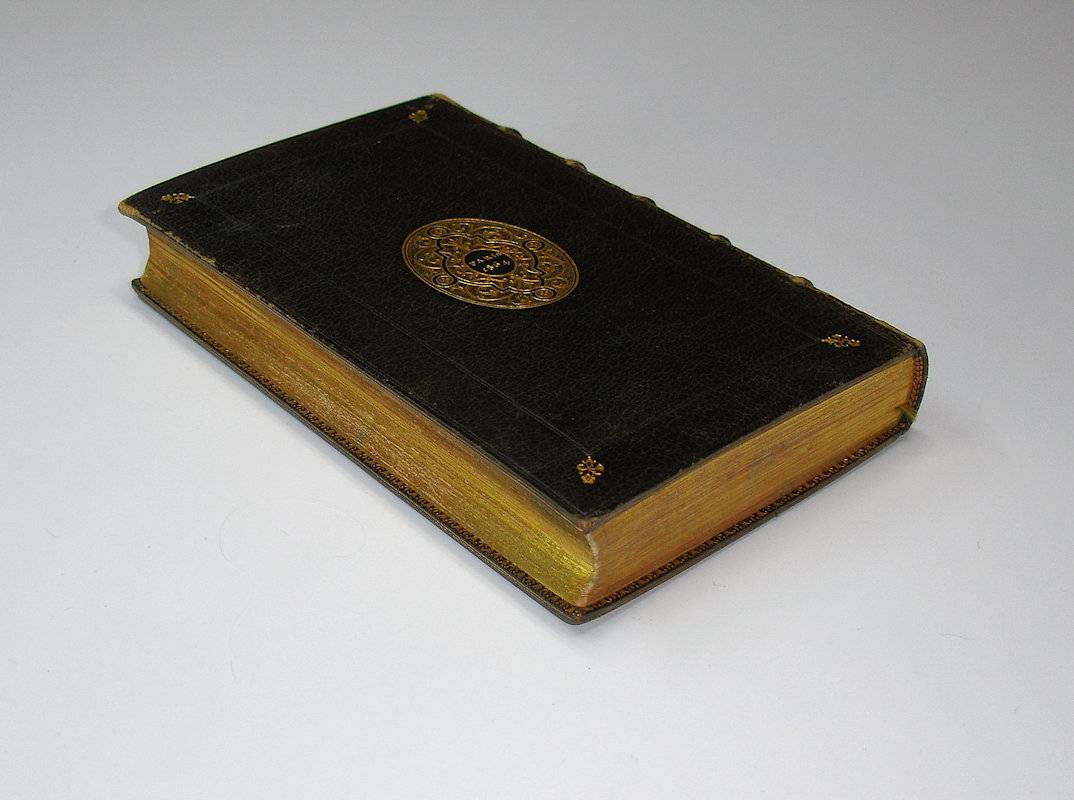HORATIUS.
Quinti Horatii Flacci Opera. Cum novo commentario ad modum Joannis Bond.
Paris (Parisiis), Ex typographia Firminorum Didot, 1855.
12mo. (VIII),46,299,(1 blank) p., including a frontispiece, engraved title, 6 photo-lithographs, 11 lithographed vignette headpieces, 2 double page maps. Brown morocco 14 cm 'Pour quelques exemplaires, la photographie, cette merveille de notre siècle, a reproduit les dessins mêmes de M. Barrias'. (
Ref: Brunet 3,325; Graesse 3,357) (
Details: Signed binding by the French bookbinder Lortic. Back with four raised bands, lettered, and with four gilt fleurons; gilt short title and imprint in the second and third compartment. Borders of the boards tooled in blind, with in the corners a gilt floral element. A fine gilt centerpiece on both boards. Gilt inside dentelles, edges gilt. Marbled endpapers. Engraved titlepage within floral borders. Photo-lithographed frontispiece made by the painter and illustrator Félix-Joseph Barrias, 6 full page photo-lithographs of Horatian sceneries painted by Jean-Achille Benouville, 11 lithographed vignette headpieces especially painted for this Didot edition by Barrias, 2 double page maps designed by the engineer Rosa. All pages have rubricated borders.
§ Dated binding, 1864, signed by Lortic. The Database of bookbindings of the British Library shows 37 copies bound by Lortic) (
Condition: Cover a bit worn at the extremes. Some almost invisible discolouring near the outer margin of the upper board. Bookplate on the front pastedown. The right lower corner is partly and very faintly dampstained) (
Note: This book is of interest for several reasons, the binding is signed and dated, and foremost, it is one of the first works of a classical author which is illustrated with photographs. (The first book with photographs ever dates from 1844) In the preface to this work of Horace the publisher, Ambroise Firmin Didot, tells that 'pour quelques exemplaires, la photographie, cette merveille de notre siècle, a reproduit les dessins mêmes de M. Barrias'. (Au lecteur p. IV). These photographically reproduced copies of pictures were separately printed and then mounted onto blank pages, and they are protected by facing tissue guards. The pictures include a full-page frontispiece, 6 landscapes of places associated with Horace and 11 scenes from the daily life in ancient Rome at the beginning of each book. This must have been an expensive production method, for the firm Didot brought also cheaper copies on the market with engravings of the illustrations.
§ In the preface Didot boasts about the excellence of this edition and about the brilliance of its typography. The Didot brothers wanted to equal the beauty of the the edition of Horace, published in 1676 by the Elzevier brothers, which was edited and commentated upon by Johannes Bond, (Willems 1517). John Bond, 1530-1612, was an English classical scholar, famous as editor and commentator of Horace. His work is incorporated in many following editions of Horace. Bond's text & commentary were, for this 1855 edition, updated by the French scholar F. Dübner. The paintings photographed were made by Félix-Joseph Barrias (1822-1907), an eminent French artist, who was a teacher of Edgar Degas, and who was very esteemed in his time, and by the wellknown landscape painter Jean-Achille Benouville) (
Provenance: 'Austrian provenance': The first owner has done this chef-d'oeuvre of the Didot brothers justice, because he had it beautifully bound. The binding is signed by the Parisian master binder P.M. Lortic (1822-1892). Before the title has been added a leaf with a dedicatory text, printed in red & black: 'Oloris Venusiani opera/ Carolo Fidlero/ paris refert/ G. Comes ab Enzenberg'. The 'Olor Venusianus' (The swan of Venusia) is of course Horace, who was born in Venusia on the 8th of dec. 63. B.C. The book was donated by a 'Graf G. (Wilhelm?) Von Enzenberg' to one 'Karl Fidler' to equal a debt, service or gift. The gilt centerpiece on the boards has in its center the initials K.F. There is a Karl Fidler, from Gallicia, born 1818, died in Vienna in 1887, who was from 1849 till 1886 a high official of the Austrian Ministery of Internal Affairs. In 1873 Karl Fidler and one 'Graf Enzenberg, k.k. Ministerial-Concipis't were members of the 'Anthropologischen Gesellschaft in Wien'. Fidler is indicated here as 'Fidler, Carl Ritter v., Sectionschef im k.k. Ministerium für Cultus und Unttericht'. In 1886, one year before his death, he was succeeded as 'Sections-Chef' by Dr. Arthur Graf von Enzenberg. A coincidence?
§ On the front pastedown the bookplate of 'Wilhelm Jerusalem'. This is most probably Wilhelm Jerusalem, an Austrian Jewish philosopher and pedagogue, born in 1854, who died in 1923 in Vienna. 'He studied classical philosophy at the University of Prague and did a doctorate on the theme The Inscription of Sestos and Polybios. Until 1887 he was a teacher at grammar schools in Prague and Nikolsburg. In 1888 he became a member of the staff of teachers at the grammar school 'k.k. Staatsgymnasium im VIII. Bezirk' in Vienna. In 1891 he was an outside lecturer (Privatdozent) at the University of Vienna. (...) After World War I he became an associate professor (außerordentlicher Professor) of philosophy and educational theory at the University of Vienna . In 1919 he became one of the teachers of the 'Schönbrunner Schule' (Schönbrunn School) which came about after the Vice Mayor of Vienna Max Winter had obtained a considerable part of the Viennese Schönbrunn Palace to be used for the advancement of the education of young women, and a small number men, to become educators and teachers. In 1923, Jerusalem became a Professor of the University of Vienna. He died of a heart attack. In 1954 a street, the Jerusalemgasse, in the 21. 'Bezirk' of Vienna was named after him. (Source Wikipedia English & German)
Book number: 120391 Euro 550.00
Keywords: (Oude Druk), (Rare Books), Didot, Horace, Horatius, Horaz, Latin literature, Photographie, antike altertum antiquity, photography, römische Literatur
 HORATIUS.
HORATIUS.